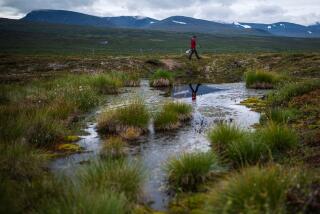Greenhouse gases could lurk beneath Antarctic ice sheet
- Share via
Enormous reservoirs of the potent greenhouse gas methane could lurk beneath the Antarctic ice sheet, hastening the rate of global warming if portions of the sheet collapse, according to a study published Thursday in the journal Nature.
Methane, a byproduct of dead and decaying organic matter, probably exists within the sediments below the ice sheet, according to study authors. Though scientists have attempted to calculate the amount of greenhouse-gas-generating substances in Arctic permafrost, they have not previously considered reservoirs of methane beneath the Antarctic ice sheet.
Using mathematical models, the study authors estimated that up to 4 billion tons of methane could reside beneath the ice sheet – almost the same amount of methane that some scientists have recently estimated exists within the Arctic permafrost.
“It’s easy to forget that 35 million years ago, when the current period of Antarctic glaciation started, this continent was teeming with life,” said Slawek Tulaczyk, a study coauthor and professor of Earth and planetary sciences at UC Santa Cruz. “Some of the organic material produced by this life became trapped in sediments, which then were cut off from the rest of the world when the ice sheet grew. Our modeling shows that over millions of years, microbes may have turned this old organic carbon into methane.”
The study was conducted by an international team of scientists and included researchers from the University of Bristol in Britain; Utrecht University in the Netherlands; and the University of Alberta in Edmonton, Canada.
The authors wrote that the methane reservoirs were likely to be shallow and could contribute to global warming if the east and west Antarctic ice sheets began to thin and retreat, as they have earlier in Earth’s history.
The authors concluded that the Antarctic ice sheet could constitute a previously neglected component of the world’s total methane inventory, but that further study was needed.
“Our study highlights the need for continued scientific exploration of remote sub-ice environments in Antarctica, because they may have far greater impact on Earth’s climate system than we have appreciated in the past,” Tulaczyk said.
Follow me on Twitter @montemorin







